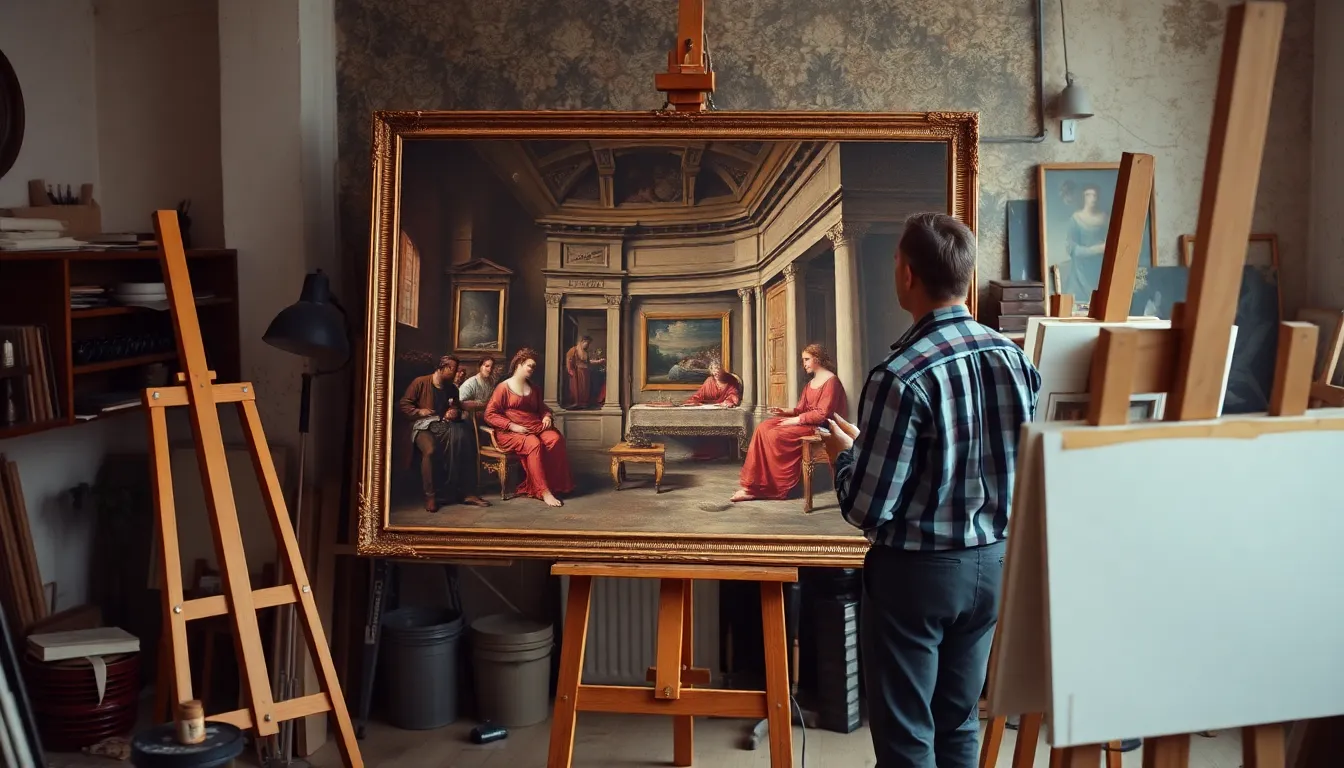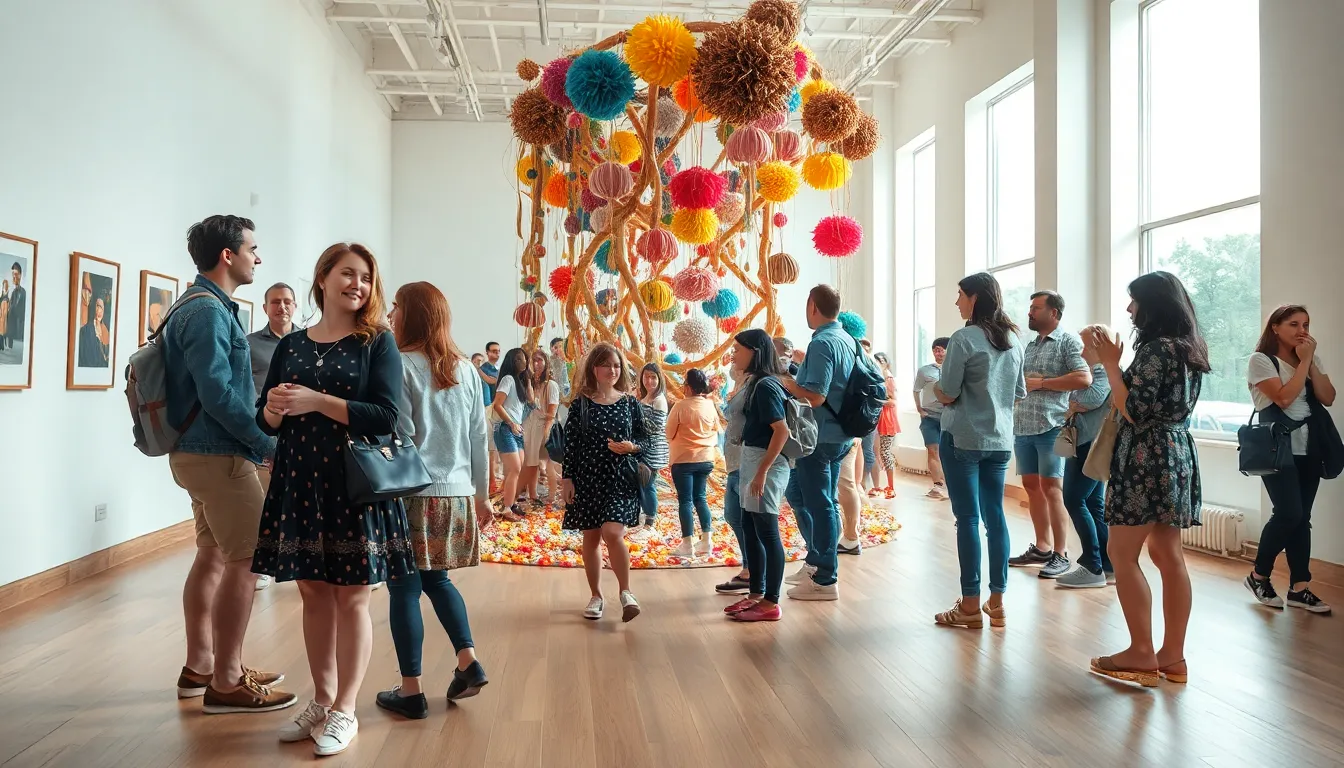Fine art isn’t just for stuffy galleries and pretentious critics. It’s a vibrant world where creativity knows no bounds and imagination runs wild. From stunning paintings that make you question reality to sculptures that seem to defy gravity, fine art invites everyone to experience beauty in its many forms.
Table of Contents
ToggleOverview of Fine Art
Fine art encompasses a range of creative expressions that prioritize aesthetic value. This category includes painting, sculpture, drawing, printmaking, and photography. Artists often use these mediums to explore complex themes, emotions, and ideas, engaging viewers on multiple levels.
Classical fine art primarily emphasizes traditional techniques and historical significance. Notable movements such as the Renaissance and Baroque periods showcase masterpieces that continue to influence contemporary artists. These works often incorporate detailed craftsmanship and strive for perfection in representation.
Modern and contemporary fine art embraces innovation and experimentation. Concepts like installation art, performance art, and digital art have emerged, pushing boundaries and redefining the art experience. The accessibility of these expressions invites a broader audience to participate in artistic dialogue.
Socio-political themes frequently emerge in fine art. Numerous artists use their work as a platform to challenge societal norms and provoke thought. Such pieces often encourage discussions about identity, culture, and the environment, resonating with diverse communities.
Many viewers find personal connections through fine art. Engaging with a piece can evoke emotions and inspire reflection. Such experiences reveal how art transcends individual perspectives, building connections among people from different backgrounds.
Art institutions and galleries play a significant role in promoting fine art. Events like exhibitions and art fairs provide opportunities for artists to showcase their work. These platforms also educate the public, fostering an appreciation for various art forms and styles.
Historical Context

Fine art has a rich history that reflects the evolution of human expression. This section explores significant periods that shaped fine art’s trajectory.
Ancient Civilizations
Ancient civilizations laid the groundwork for what would become fine art. Artists created pottery, sculptures, and murals, often with religious or cultural significance. The Egyptians, for example, produced intricate hieroglyphics and detailed tomb paintings to honor the afterlife. Similarly, Greeks emphasized realism in sculpture, celebrating the beauty of the human form. Artistic practices in these civilizations reveal social values and beliefs, showcasing how art served both aesthetic and functional purposes.
Renaissance Impact
The Renaissance marked a turning point in fine art history. This period reintroduced classical themes, emphasizing perspective and human emotion in painting and sculpture. Artists like Leonardo da Vinci and Michelangelo exemplified mastery of technique and creativity, crafting works that communicated depth and realism. Innovations in oil painting transformed texture and color use, allowing for greater expressive capabilities. The intersection of science and art during the Renaissance inspired a generation of creators to challenge conventions and push artistic boundaries, setting the stage for modern artistic movements.
Key Characteristics of Fine Art
Fine art encompasses various distinctive features that set it apart from other artistic forms. Its emphasis on aesthetic value and emotional response often resonates with viewers, creating memorable experiences.
Aesthetic Value
Aesthetic value serves as a cornerstone of fine art. Artists prioritize beauty through composition, color, and form. Each piece invites viewers to engage, often sparking appreciation for creative expression. Paintings with vibrant hues or sculptures with intricate details captivate audiences. Through diverse mediums, aesthetics stimulate interest in both traditional and contemporary art. Artworks can challenge perceptions while highlighting the skill of the artist. Exceptional pieces often redefine standards of beauty within society. Fine art’s unique ability to evoke visual pleasure remains crucial to its significance.
Emotional Response
Emotional response remains a vital aspect of fine art. Many artworks evoke profound feelings, guiding viewers through personal reflections. Viewer engagement with art often leads to emotional connections. Themes of love, loss, and hope resonate deeply and can elicit strong reactions. Artists intentionally explore these complexities, probing various human experiences. Art can provoke thought, influencing individual perceptions of reality. Each interaction with a piece might inspire contemplation or even transform attitudes towards life. This emotional engagement underscores fine art’s power to provoke meaningful discussions and foster connections.
Different Forms of Fine Art
Fine art encompasses a diverse array of creative expressions that evoke aesthetic appreciation and emotional resonance. Each form offers unique insights and experiences for both artists and viewers.
Painting
Painting remains one of the most recognized forms of fine art. Artists employ various techniques and materials, including oil, acrylic, and watercolor, to create works that express emotions and concepts. Styles range from realistic depictions to abstract representations, each engaging viewers in different ways. The use of color, texture, and composition plays a crucial role in conveying meaning. Artists like Vincent van Gogh and Georgia O’Keeffe exemplify the emotional depth achieved through painting, inviting audiences to immerse themselves in their distinct perspectives.
Sculpture
Sculpture stands out as a three-dimensional fine art form that challenges perceptions of space and form. Artists utilize materials such as stone, metal, clay, and wood to craft objects that can be both intricate and monumental. Traditional techniques often contrast with contemporary approaches, where mixed media and installation become common. This versatility allows sculptors to explore various themes, from identity to environmental issues. Notable figures like Auguste Rodin and Henry Moore demonstrate the profound impact sculpture can have on public spaces and emotional engagement.
Photography
Photography has evolved into an essential medium within the realm of fine art. Artists capture moments in time using both digital and film techniques, exploring themes such as identity, nature, and social commentary. Innovative approaches like photo manipulation or mixed media push boundaries, creating new visual narratives. With the rise of social media, photographers can reach wider audiences, challenging traditional definitions of fine art. Pioneers like Ansel Adams and Cindy Sherman have significantly shaped the medium, showcasing its potential to provoke thought and inspire change.
Contemporary Trends in Fine Art
Contemporary fine art showcases a variety of exciting trends reflecting current societal themes and advancements in technology. Artists increasingly explore innovative mediums that engage diverse audiences.
Digital Art
Digital art has transformed how artists create and share their work. This medium includes digital painting, 3D modeling, and animation, allowing for endless possibilities in expression. Platforms like social media enable artists to reach global audiences instantly. NFT technology has further shifted the landscape, providing unique ownership and monetization opportunities for digital pieces. Creators, such as Beeple, demonstrate the potential impact of digital formats on the art market, blurring the lines between traditional and contemporary forms.
Installation Art
Installation art offers immersive experiences that challenge conventional viewing practices. This genre often utilizes various materials and technologies to create site-specific works that engage viewers on multiple sensory levels. Notable examples include large-scale installations that incorporate sound, light, and interactive components, inviting audience participation. Artists like Yayoi Kusama and Olafur Eliasson excel in transforming spaces, captivating participants and prompting reflections on identity and environment. By breaking traditional boundaries, installation art invites deeper engagement and redefines the viewer’s role in the artistic experience.
Fine art transcends traditional boundaries and invites everyone to explore its rich tapestry. It’s a powerful medium that not only reflects societal values but also provokes thought and inspires emotional connections. Each artwork serves as a window into the artist’s mind and the world around them, encouraging viewers to engage with complex themes and personal reflections.
As fine art continues to evolve, it embraces innovation while honoring its historical roots. The dynamic interplay of various forms and styles ensures that fine art remains relevant and accessible. By fostering appreciation and dialogue, fine art enriches cultural landscapes and enhances our understanding of the human experience.



